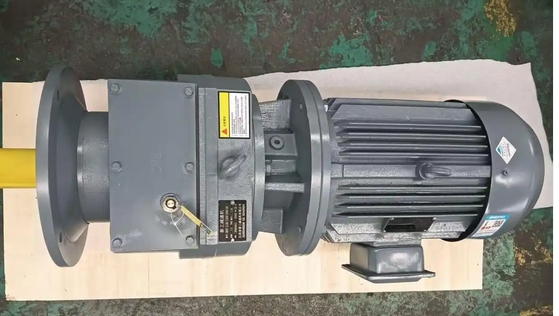What advanced technologies or methods can be used for the maintenance of the GRF97-7.5KW-25.03 reducer?
Here are some advanced technologies and methods that can be used for maintenance of GRF97-7.5KW-25.03 gearbox:
Oil monitoring technology
Online oil analysis system: Install oil sensors on the reducer to monitor real-time parameters such as temperature, pressure, viscosity, density, dielectric constant, moisture, metal wear particles, conductivity, etc. of the lubricating oil. By analyzing these data, the deterioration trend of lubricating oil and potential equipment failures can be detected in a timely manner, such as an increase in metal wear particles, which may indicate increased wear of gears or bearings, providing scientific basis for preventive maintenance.

Regular oil testing: Regularly taking oil samples for laboratory testing can more accurately analyze the physical and chemical properties and pollution level of the oil, including testing the additive content, acid value, flash point and other indicators in the oil to determine whether the lubricating oil needs to be replaced and the wear condition inside the gearbox.
Intelligent monitoring and diagnostic technology
Install sensors for status monitoring: Install temperature sensors, vibration sensors, and acoustic emission sensors in key parts of the gearbox, such as bearing seats and gearboxes. The temperature sensor can monitor temperature changes in real time. When the temperature exceeds the set threshold, it will promptly issue an alarm signal, indicating possible problems such as poor lubrication, excessive load, or internal faults. The vibration sensor can detect the amplitude and frequency of the gearbox's vibration, and analyze the vibration signal to determine whether there are wear, looseness, or imbalance faults in components such as gears and bearings. Acoustic emission sensors can capture the acoustic emission signals generated by small cracks, friction, etc. inside the device, which helps to detect potential faults and hidden dangers early.
Remote monitoring system based on the Internet of Things and big data: The sensor data of the gearbox is transmitted to the remote monitoring center through Internet of Things technology, and a large amount of operational data is analyzed and processed using big data analysis and artificial intelligence algorithms. It can achieve remote real-time monitoring, fault warning, and diagnosis of the gearbox. Technical personnel can understand the operating status of the equipment without going to the site, discover problems in a timely manner, and take corresponding maintenance measures to improve maintenance efficiency and equipment reliability.
nondestructive testing
Infrared thermal imaging detection: By scanning the reducer with an infrared thermal imaging instrument, the temperature distribution on the surface of the equipment can be intuitively displayed. Being able to quickly detect localized overheating areas, such as bearing failures, poor gear meshing, or insufficient lubrication causing heating, in order to conduct timely maintenance and avoid further deterioration of the fault.
Ultrasonic testing: used to detect defects in internal components of reducers, such as cracks in gears, damage to bearings, etc. The ultrasonic flaw detector emits ultrasonic pulses to determine whether there are defects inside the components based on the reflected waves. It has the advantages of non-contact, fast, and accurate detection, and can be carried out during equipment operation or shutdown.

